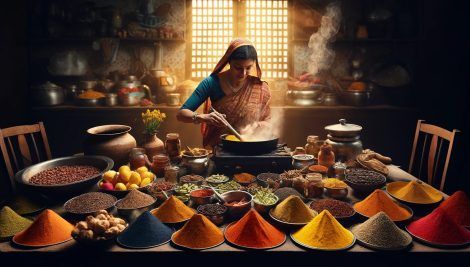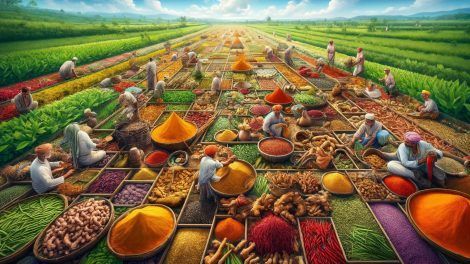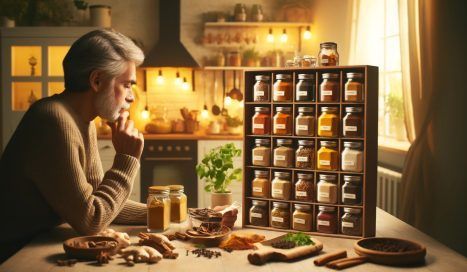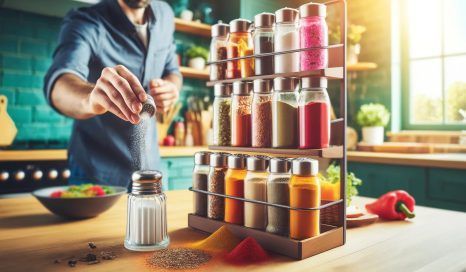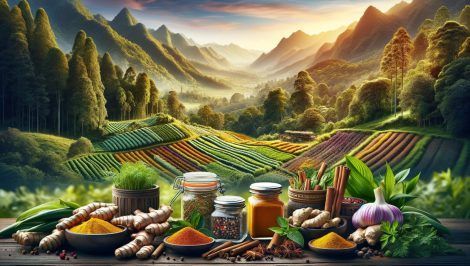- You have no items in your shopping cart
- Subtotal: ₹0.00
Trying Unique Indian Spices from Home

Indian food is well known for its vivid colors, flavorful blends, and fragrant pure Indian spices. It is a gastronomic tapestry woven with the distinctive tastes and cooking methods of different parts of the nation. Indian cuisine offers a wide variety of regional delicacies that highlight the nation’s cultural diversity, from the spicy curries of the North to the fragrant biryanis of the South.
In-depth instructions on simple techniques to prepare Indian cuisines at home are included in this thorough guide, along with a list of necessary tools, ingredients, and methods.
As you begin your culinary exploration of Indian cuisine, experimenting with recipes and flavors, it’s worthwhile to delve into the many regional cuisines and blend ingredients from throughout the country, which you can explore later. Trust me, you will be able to fully appreciate the diversity and depth of Indian food.
Crucial Spices:
Indian cuisine uses various spices, including cumin, coriander, turmeric, garam masala, red chili powder, mustard seeds, cardamom pods, cinnamon sticks, cloves, and fenugreek seeds.
- Cumin has an earthy, warm flavor and can be used in whole and ground forms.
- Coriander offers a citrusy and slightly sweet flavor, complementing curries, marinades, chutneys, and spice blends.
- Turmeric, known as the “golden spice,” adds a vibrant yellow color and mild, earthy flavor to curries, rice, lentils, and vegetable dishes.
- Garam masala is a fragrant blend of ground pure Indian spices, while red chili powder adds heat and spice.
- Mustard seeds, cardamom pods, cinnamon sticks, cloves, and fenugreek seeds are used in tempering, spice blends, and pickles.
Vital Tools:
To make Indian cooking more efficient and enjoyable, invest in essential tools such as a spice grinder, pressure cooker, tawa, kadai, spice box, stainless steel pots and pans, chopping board, sharp knives, stainless steel or copper utensils, sieve or strainer, and hand blender or food processor.
- A spice grinder is essential for releasing maximum flavor and aroma, while a pressure cooker is time-saving for cooking lentils, beans, and rice.
- Tawa is a flat griddle for even heat distribution.
- Kadai is a deep, wide-mouthed pan for frying, sautéing, and deep-frying.
- Spice box, also known as a “masala dabba”, keeps pure Indian spices organized and protected from moisture and light.
- Stainless steel or copper utensils are known for their excellent heat conductivity and durability.
Essential Techniques:
To achieve authentic Indian flavors and textures in dishes, master key techniques such as tempering (Tadka), dry roasting pure Indian spices, making fresh spice pastes, slow cooking, dough preparation for bread, and balancing flavors.
- Tempering involves roasting whole spices in hot oil or ghee to extract their aroma, while dry roasting spices intensify their flavors.
- Making fresh spice pastes from ginger, garlic, onions, and other aromatic ingredients is essential for creating a consistent texture and well-incorporated flavors.
- Slow cooking allows flavors to meld together and develop richness.
- Dough preparation for bread requires a soft and pliable dough that can be kneaded thoroughly to develop gluten and create a lighter texture.
- Rice preparation is crucial for achieving fluffy, separate grains, and adjusting the seasoning accordingly to balance flavors.
- Tamarind pulp, lemon juice, yogurt, or a touch of sugar are commonly used to achieve this balance, bringing harmony to the dish and enhancing the overall taste experience.
By mastering these techniques, you can create dishes with authentic Indian flavors and textures.
Tips & Tricks:
- To enhance the flavor of Indian cuisine, toast and grind whole pure Indian spices before grinding them to add depth and complexity, also try to buy Indian spices online and explore them.
- Use fresh ingredients like ginger, garlic, and herbs to elevate the flavors.
- Adjust spice levels gradually to your taste preferences, starting with a small amount and gradually increasing if desired.
- Incorporate yogurt or cream for richness and balance, mellowing flavors and providing a velvety texture.
- Garnish dishes with fresh herbs and fried onions for a burst of freshness and texture.
Remember to adjust spice levels to your taste preferences.
Dear Chef, be mindful of these too:
Indian cuisine requires careful cooking to maintain its delicate flavors.
- Avoid overcooking spices like saffron and cardamom, which can result in a bitter taste.
- Slowly simmer and slow-cook dishes to develop flavors, avoiding overcrowding the pan.
- Adjust seasoning as needed to achieve a balanced flavor profile.
- Cook in batches if needed to ensure even cooking and caramelized exterior.
- Rest and marinate meats and vegetables to maximize flavor.
- Balancing pure Indian spices with other ingredients like tomatoes, yogurt, coconut milk, and citrus juices helps balance flavors and provide a refreshing contrast.
Don’t be afraid to experiment with different spice combinations, ingredient substitutions, and techniques. Embrace your creativity and adapt recipes to suit your taste preferences.
Conclusion:
Remember that it takes time and effort to become an expert in Indian cooking. Start with tiny amounts of these pure Indian spices in your cuisine so you can get a sense of their flavor and strength. You can experiment with mixing spices into different concoctions or utilize them separately in other recipes. It is now simpler to explore and savor the varied world of Indian spices from the comfort of your home because many of these spices are sold at specialty grocery stores or you can buy Indian spices online. Don’t let the early difficulties deter you. Accept the process of learning, take in the scents, and relish the delectable outcomes. You can make delicious, authentic Indian food in your kitchen with the correct spices, equipment, methods, and a little bit of culinary curiosity. Have fun in the kitchen!
While the journey of trying out Indian spices at home can seem like a lot of fun, it may sometimes become overwhelming. So, what can you do? Do you halt your voyage through the richness of Indian spices? No, there’s an exciting solution waiting for you. You can buy Indian spices online from EFGH, where authentic masala blends are meticulously crafted from handpicked pure Indian spices.

